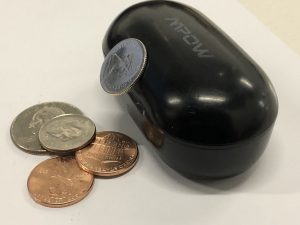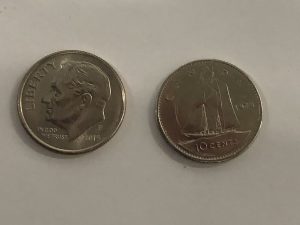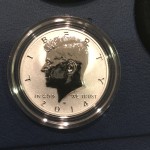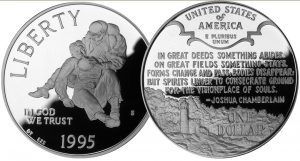Being amused by a nickel dime
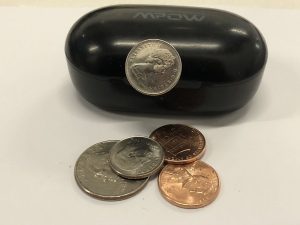 With everything going on, it is nice to find something amusing. Over the weekend, I wanted to listen to a couple of podcasts. I reached into my pocket for the case containing my wireless earbuds and found something came along for the ride.
With everything going on, it is nice to find something amusing. Over the weekend, I wanted to listen to a couple of podcasts. I reached into my pocket for the case containing my wireless earbuds and found something came along for the ride.
Stuck to the magnetic closure was a coin. A closer look found the coin is a 1978 Canada 10-pent coin. Or that is what the coin appears to be.
The Canada 10-cent coin is slightly larger than the U.S. dime (18.03 mm versus 17.91 mm), and today, the Canadian coin is made of plated steel. But this is a 1978 coin and may not be steel. While investigating the coin’s specification, it is supposed to be made of nickel. I thought nickel was not magnetic. Time to review my basic science
- My earbud case magnetized the Canada 10¢ coin made of nickel.
- The Canada 10¢ coin is very slightly larger than the U.S. dime.
Nickel is one of the transition metals, an element used to form bonds with other elements. While I let you explore the chemistry on your own, let us say that it mixes well with other elements to create valuable compounds. In numismatics, nickel provides the silver color on many base metal coins.
But that does not explain why the coin stuck to my wireless earphone case.
I found that nickel is a ferromagnetic metal, meaning that it can become magnets or be attracted to magnets. Nickel is not naturally attracted to magnets or easily magnetized. But nickel is one of only four elements that can be magnetized easily at room temperature. The other three are cobalt, iron, and gadolinium.
For help, I turned to a high school chemistry teacher to refresh my memory. During the refresher lesson, I flashed back to the high school chemistry demonstration on magnetism, creating a magnet from a ferromagnetic item.
While the coin was in my pocket, the coin rubbed next to the magnet. The rubbing caused the nickel atoms to become orderly that turned the coin into a magnet. The Canadian ten-cent coin that stuck to the earbud case could pick up a straight pin to test the theory.
But why won’t any of my United States coins turn into a magnet in my pocket?
Since U.S. coins are made up of an alloy of 75-percent copper and 25-nickel, the copper and the nickel’s strong bond with the copper stops the ferromagnetic process. It would take a very strong magnet to order the nickel atoms in a U.S. coin to turn it into a weak magnet.
Not only can coins teach history, but they can also teach chemistry.
May 2017 Numismatic Legislation Review
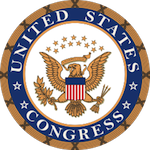 Just because congress is dysfunctional does not mean they cannot curry favor with various constituencies. This month we see bills introduced for a Coast Guard and American Legion 100th Anniversary commemorative coins programs. Both are worthy organizations but given the toxic nature of Congress, who knows if these commemorative programs will be passed.
Just because congress is dysfunctional does not mean they cannot curry favor with various constituencies. This month we see bills introduced for a Coast Guard and American Legion 100th Anniversary commemorative coins programs. Both are worthy organizations but given the toxic nature of Congress, who knows if these commemorative programs will be passed.
To pair with the Currency Optimization, Innovation, and National Savings (COINS) Act (S. 759) introduced by Sen. John McCain (R-AZ), there is now a version introduced in the house (H.R. 2299). Even though it is a good idea, it will not be supported in the current environment.
I wish some of these bills had a chance….
H.R. 2299: Currency Optimization, Innovation, and National Savings Act of 2017
This bill can be tracked at http://bit.ly/115-hr2299.
H.R. 2317: United States Coast Guard Commemorative Coin Act of 2017
This bill can be tracked at http://bit.ly/115-HR2317.
S. 1021: United States Coast Guard Commemorative Coin Act of 2017
This bill can be tracked at http://bit.ly/115-S1021.
S. 1182: The American Legion 100th Anniversary Commemorative Coin Act
This bill can be tracked at http://bit.ly/115-S1182.
H.R. 2519: The American Legion 100th Anniversary Commemorative Coin Act
This bill can be tracked at http://bit.ly/115-HR2519.
JFK 100
 John Fitzgerald Kennedy was the second son of Joe and Rose Kennedy. Born on May 29, 1917 in Brookline, Massachusetts, Jack, as he was known to family and friends, was born of privilege and lead that life being able to travel the world in his younger days. It also helped that his father was named Ambassador to the Court of St. James (London).
John Fitzgerald Kennedy was the second son of Joe and Rose Kennedy. Born on May 29, 1917 in Brookline, Massachusetts, Jack, as he was known to family and friends, was born of privilege and lead that life being able to travel the world in his younger days. It also helped that his father was named Ambassador to the Court of St. James (London).
He used his experience to better understand the plight of people and majored in government at Harvard College. For his honors thesis, Kennedy toured the Soviet Union, the Balkans, and the Middle East to research different political philosophies. He later was in Germany when the German Army invaded Poland marking the beginning of World War II. With his father still in London, they attended the House of Commons supporting the declaration of war on Germany.
On his return to the United States, Kennedy tried to enter the Army’s Officer Candidate School but was medically ineligible because of chronic lower back problems. He used his family’s connections to join the U.S. Naval Reserves. During World War II, he famously commanded PT-109.
Following the death of his elder brother in 1944, Kennedy was tapped by his father to run for office. Kennedy won his first election in 1946 to serve two terms in the House. In 1952, Kennedy ran for the Senate against three-term incumbent Henry Cabot Lodge Jr. The popularity of Dwight Eisenhower running for the president did not help Lodge as Kennedy was able to win by 70,000 votes.
While trying to overcome the “Catholic question,” Kennedy his opponent, Richard Nixon, held three debates. Although not much is said about the last two debates, the first one was historic. Kennedy used makeup and appeared cool and presidential. Nixon looked nervous, sweaty, and his five o’clock shadow did not help. When the debate was over, those watching on television thought Kennedy won while those listening on radio thought Nixon won. It was a fascinating use of new media and set the tone for presidential races to come.
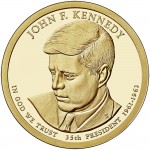 Kennedy won the 1960 election by two-tenths of the popular vote and exceeded the Electoral College by a 303-219 margin even though 14 electors from Alabama and Mississippi refused to support him because of his stance on civil rights. Kennedy became the youngest person ever elected president.
Kennedy won the 1960 election by two-tenths of the popular vote and exceeded the Electoral College by a 303-219 margin even though 14 electors from Alabama and Mississippi refused to support him because of his stance on civil rights. Kennedy became the youngest person ever elected president.
 There were a lot of accomplishments and difficulties during the term of the 35th president that there are too many to highlight here. But one that is significant in the current numismatic world was the speech he made at Rice University in support of the space program. At the time Kennedy was pushing for the funding to enter the space race, Congress was skeptical over spending the money. His impassioned speech to the students at Rice as well as several others around the nation helped gain public support. Congress eventually funded the space program.
There were a lot of accomplishments and difficulties during the term of the 35th president that there are too many to highlight here. But one that is significant in the current numismatic world was the speech he made at Rice University in support of the space program. At the time Kennedy was pushing for the funding to enter the space race, Congress was skeptical over spending the money. His impassioned speech to the students at Rice as well as several others around the nation helped gain public support. Congress eventually funded the space program.
In 2019, we will be celebrating the 50th anniversary of making it to the moon by the end of that decade with the Apollo 11 Commemorative Coin program. Phase One of the competition ends on June 29, 2017, or until 1,000 entries are received. Visit the U.S. Mint’s competition page for more information.
Would the United States have made it to the moon by the end of the 1960s and beaten the Russians there without Kennedy? We may not be able to answer that question but we do know he set the policies that will allow for the celebration in two years.
Happy 100th Birthday to President John F. Kennedy.
- 2017 Kennedy Half Dollar and 2015 Kennedy Dollar images courtesy of the U.S. Mint.
- All other images are property of the author.
Memorial Day 2017
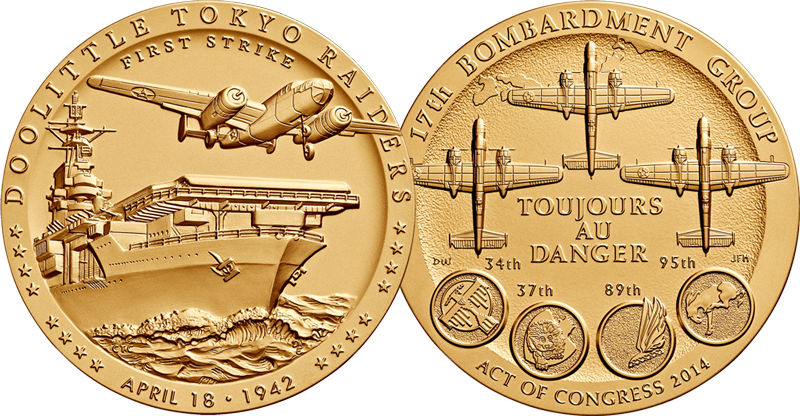
The last surviving member of Doolittle’s Raiders is Lt. Col. Richard Cole, Doolittle’s co-pilot. Cole is now 101 years old. Click here to read about Cole and Doolittle’s Raid on Japan that helped the U.S. launch the War in the Pacific.
Southern states began their own commemoration to honor their soldiers who died during the war. No specific date was used but occurred in late April through June. By 1880, there was a more organized Confederate Memorial Day. These celebrations honored specific soldiers to commemorate the Confederate “Lost Cause.” By 1913, a sense of nationalism saw a commemoration of all soldiers that have died in battle.
Memorial Day took on national significance following World War I when the nation began to recognize all those who gave the ultimate sacrifice during all conflicts. By the end of World War II, most of the celebrations were renamed to Memorial Day. Memorial Day did not become an official holiday until 1967 with the passage of the Uniform Holidays Act in 1968. Under the law, Memorial Day was set to the last Monday in May, changing it from the traditional May 30th.Memorial Day is the national remembrance of those who made the ultimate sacrifice for this country. Please take a moment and honor the memories of those who have died for without them who knows where we would be today.

Visitors are reflected in the Vietnam Memorial in Washington, May 27, 2016. (Susan Walsh/AP Photo via ABC News)
U.S. Mint to stop taking mail orders
 When official Washington has an announcement or news that they want to bury as much as possible, they issue press releases after 5:00 PM on Friday, especially before a holiday weekend. Although this type of announcement was coming sooner or later, the U.S. Mint announced that they will stop accepting and filling orders mailed to them after September 30, 2017, the end of the 2017 federal government fiscal year (FY2017).
When official Washington has an announcement or news that they want to bury as much as possible, they issue press releases after 5:00 PM on Friday, especially before a holiday weekend. Although this type of announcement was coming sooner or later, the U.S. Mint announced that they will stop accepting and filling orders mailed to them after September 30, 2017, the end of the 2017 federal government fiscal year (FY2017).
Beginning on October 1, 2017, the only option to order products directly from the U.S. Mint will be through their online catalog or via telephone at 1-800-USA-MINT (872-6468). Telephone orders may be placed seven days a week from 8:00 AM to midnight Eastern Time.
The U.S. Mint tried this once before but after a lot of pushback from congress the policy was reversed and they just removed the order insert from their promotional mailings. This announcement sets the cut-off date one year later than the previous announcement.
This will probably not sit well specifically with older collectors that have not adapted to the online world. Unfortunately, these are becoming the vast minority of collectors since the U.S. Mint fills more orders from online purchases than any other option. In fact, when you call the toll-free number to order, the customer service representative (CSR) is using the same website that the rest of us are doing to enter your order. I found this out when I called to inquire about and order and questioned the CSR about what she was doing.
With the youngest of the Baby Boomer generation becoming 53 this year, the markets are geared for the GenX, Millenials (GenY), and GenZ (those born after 2000). The U.S. Mint has to keep up with the markets while being able to hold down costs. Removing the snail mail option will help keep costs down. As a member of the Baby Boomer generation, with my own AARP card, I do not remember the last time I purchased something from the U.S. Mint by mail or telephone. Almost everything I have bought has either been online or when the U.S. Mint has had a presence at coin shows.
Even my father, who was born before World War II, orders using the U.S. Mint’s website!
Do not worry if you do not want to use the website. The U.S. Mint will not be ending their telephone ordering system anytime in the near future. Telephone ordering allows the U.S. Mint to support universal access even for those whose abilities prevent the use of the website or who may not have access to the Internet, for whatever reason. It is part of the laws and mandates to keep the government accessible to all of its constituents. Until the technology is available to support universal access online, then the telephone ordering system will continue to be there as an alternative.
ANA Election: VOTE!
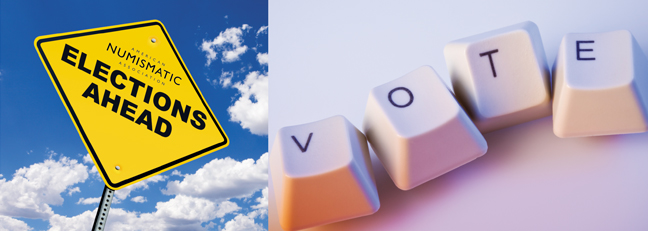 Earlier this week I received the ballot information for the election of the American Numismatic Association Board of Governors. There are two candidates for president, one for vice president, and eight for Governors which seven will be selected.
Earlier this week I received the ballot information for the election of the American Numismatic Association Board of Governors. There are two candidates for president, one for vice president, and eight for Governors which seven will be selected.
As some of you who are ANA member began to receive your ballots, I have received many emails asking who I support. Since the slate is smaller this year, there is not a big choice. But as a preliminary answer, I have expressed my preference for one of the candidates not be elected as ANA President. I continue to stand by that assessment. Even if Gary Adkins was running unopposed, there would be no issue with supporting his candidacy.
There is also no problem with Don Kagin becoming Vice President. I believe Kagin is the first person who has a Ph.D. in numismatics, is a successful dealer, and I believe is someone good for the ANA.
As for the Board of Governors, only seven of the eight will be elected to the Board. The anti-incumbent sentiment in me says that I should support all those running for the first time: Adam J. Crum, Brian Hendelson, John W. Highfill, and Thomas J. Uram. After reading their statements and watching the candidate forum video, all four will do well.
That means one of the four incumbents have to go. Trying to decide between Steve Ellsworth, Greg Lyon, Paul Montgomery, and Ralph W. Ross is not as easy as I initially thought it would be. I know where I am leaning and why, but I want to take some time to consider my position. I will make my decision sometime the beginning of June.
Until then, you may want to spend the hour-and-forty-seven minutes and watch the candidates forum:
